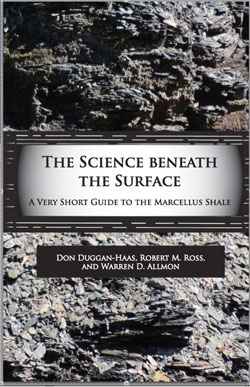Book offers simplified guide to shale gas extraction
By Susan S. Lang

The new book, “Science Beneath the Surface: A Very Short Guide to the Marcellus Shale,” attempts to offer a reader-friendly, unbiased, scientific guide needed to make well-informed decisions regarding energy use and, more specifically, hydraulic fracturing (“fracking”) in the Marcellus Shale.
The 252-page book was published recently by the Paleontological Research Institution (PRI), a Cornell affiliate. It was co-authored by Robert Ross, paleobiologist and associate director of outreach at PRI; Don Duggan-Haas, PRI educational researcher; and Warren Allmon, Cornell professor of paleontology and executive director of PRI/Museum of the Earth. It includes contributions by educators Kelly E. Cronin, Trisha A. Smrecak and Sara Auer Perry.
“We are making scientific information accessible,” Ross says. “We are not trying to convince people that drilling should or should not take place. We have gathered credible scientific information from a variety of sources and made it easier to understand in a noncontentious way.”
The Marcellus Shale is a vast rock formation that holds a huge reservoir of natural gas; it is at the center of one of the most controversial natural resources issues of our time, say the authors. This is primarily because of the unconventional method used to extract gas from the shale – slickwater horizontal high-volume hydraulic fracturing, or hydrofracking. Concerns about how widespread use of the practice will affect the natural environment – most especially freshwaters at the local level and climate at the global level – have thrust geology into the public view. This book, funded by National Science Foundation grants, reviews the major science and technology issues around this complex topic, offering impartial, evidence-based, thought-provoking information to help citizens decide what to do.
The chapters include the geology of the Marcellus Shale; the technology of shale gas extraction, water and other environmental impacts of shale gas extraction; the implications of the Marcellus Shale extraction in a broader energy context and teaching about the Marcellus Shale. The 10th and final chapter of the book, called “So What?” attempts to “summarize the current state of what science ‘knows’ (i.e., has reached a reasonable consensus on) about natural gas in the Marcellus Shale,” all the while acknowledging that “there is ample reason to believe that many aspects of this tentative consensus might change in the near future as research proceeds,” wrote the authors.
Media Contact
Get Cornell news delivered right to your inbox.
Subscribe